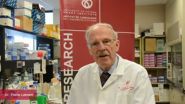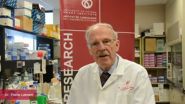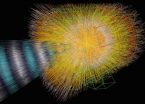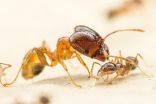(Press-News.org) VIDEO:
Dr. Frans Leenen, from the University of Ottawa Heart Institute, discusses the importance of these new findings.
Click here for more information.
Ottawa, ON and Baltimore, MD, October 2, 2014—New research by scientists at the Ottawa Heart Institute and the University of Maryland School of Medicine (UM SOM) has uncovered a new pathway by which the brain uses an unusual steroid to control blood pressure. The study, which also suggests new approaches for treating high blood pressure and heart failure, appears today in the journal Public Library of Science (PLOS) One.
"This research gives us an entirely new way of understanding how the brain and the cardiovascular system work together," said Dr. John Hamlyn, professor of physiology at the University of Maryland School of Medicine, one of the principal authors. "It opens a new and exciting way for us to work on innovative treatment approaches that could one day help patients."
For decades, researchers have known that the brain controls the diameter of the peripheral arteries via the nervous system. Electrical impulses from the brain travel to the arteries via a network of nerves known as the sympathetic nervous system. This system is essential for daily life, but is often chronically over active in patients with high blood pressure or heart failure. In fact, many drugs that help with hypertension and heart failure work by decreasing the activity of the sympathetic nervous system.
However, these drugs often have serious side effects, such as fatigue, dizziness, depression and erectile dysfunction. "These drawbacks have led to the search for novel ways to inhibit sympathetic nerve action while causing fewer problems for patients," says Dr. Frans Leenen, Director of Hypertension at the Ottawa Heart Institute, and a principal author of the study.
Working with an animal model of hypertension, Dr. Leenen in collaboration with Dr. Hamlyn and Dr. Mordecai Blaustein, professor of physiology and medicine at the UM SOM, found a new link between the brain and increased blood pressure, namely, a little-known steroid called ouabain (pronounced WAH-bane). This new study is the first to identify a particular pathway by which the brain regulates the diameter of the arteries via ouabain in the bloodstream, and causes an increase in contractile proteins in the arteries. This new humoral "chronic" pathway acts together with the more "acute" sympathetic nervous system pathway to control the function of arteries and thereby contributes to e.g. high blood pressure.
"Now that we understand the role of ouabain, we can begin working on how to modify this new pathway to help people with cardiovascular problems," said Dr. Blaustein. "The potential for this is big." Dr. Blaustein, who has been doing research on the substance since 1977, said medications that block ouabain's effects might improve the lives of people with hypertension and heart failure.
INFORMATION:
The research was funded by the Canadian Institutes of Health Research, the National Institutes of Health, and the University of Maryland School of Medicine.
About the University of Ottawa Heart Institute
The University of Ottawa Heart Institute (UOHI) is Canada's largest and foremost heart health centre dedicated to understanding, treating and preventing heart disease. UOHI delivers high-tech care with a personal touch, shapes the way cardiovascular medicine is practised and revolutionizes cardiac treatment and understanding. It builds knowledge through research and translates discoveries into advanced care. UOHI serves the local, national and international community and is pioneering a new era in heart health.
http://www.ottawaheart.ca
About the University of Maryland School of Medicine
The University of Maryland School of Medicine was chartered in 1807 and is the first public medical school in the United States and continues today as an innovative leader in accelerating innovation and discovery in medicine. The School of Medicine is the founding school of the University of Maryland and is an integral part of the 11-campus University System of Maryland. Located on the University of Maryland's Baltimore campus, the School of Medicine works closely with the University of Maryland Medical Center and Medical System to provide a research-intensive, academic and clinically based education. With 43 academic departments, centers and institutes and a faculty of more than 3,000 physicians and research scientists plus more than $400 million in extramural funding, the School is regarded as one of the leading biomedical research institutions in the U.S. with top-tier faculty and programs in cancer, brain science, surgery and transplantation, trauma and emergency medicine, vaccine development and human genomics, among other centers of excellence. The School is not only concerned with the health of the citizens of Maryland and the nation, but also has a global presence, with research and treatment facilities in more than 30 countries around the world. http://medschool.umaryland.edu/
Biologists from the University of York have compiled two new datasets on insect evolution, revealing that metamorphosing insects diversify more quickly than other insects and are therefore the biggest contributors to the evolution of insect diversity.
Both funded by the Natural Environment Research Council (NERC), the first dataset is a complete fossil catalogue showing timescales of origination and extinction of different families of insects. Working with the Natural History Museum and National Museums Scotland, former PhD student Dr David Nicholson collated a database ...
By combining data from two high-energy accelerators, nuclear scientists have refined the measurement of a remarkable property of exotic matter known as quark-gluon plasma. The findings reveal new aspects of the ultra-hot, "perfect fluid" that give clues to the state of the young universe just microseconds after the big bang.
The multi-institutional team known as the JET Collaboration, led by researchers at the U.S. Department of Energy's Lawrence Berkeley National Lab (Berkeley Lab), published their results in a recent issue of Physical Review C. The JET Collaboration ...
As the Supreme Court of the United States begins its fall 2014 session this month, it faces decisions on several "blockbuster" cases, including freedom of speech, religious freedoms in prison, pregnancy discrimination and a possible decision on gay marriage.
Just don't expect any of these decisions until next June, just before the court's session ends.
New research from the Washington University in St. Louis School of Law finds big, or "blockbuster," cases are disproportionately decided at the end of June, just before the court's summer recess.
"We knew that more than ...
Older parents, birth defects, maternal nutrition and childhood exposure to CT scans and pesticides are increasingly being associated with brain tumors in children, according to new research from the Brown School at Washington University in St. Louis.
Brain and central nervous system tumors are the second leading cause of cancer death in children.
A team of researchers, led by Kimberly Johnson, PhD, assistant professor of social work at the Brown School, a member of the Institute for Public Health and a research member of Siteman Cancer Center, examined studies published ...
Where are the quantum computers? Aren't they supposed to be speeding up decryption and internet searches? After two decades of research, you still can't find them in stores. Well, it took two decades or more of research dedicated to semiconductors and circuit integration before we had digital computers. For quantum computers too it will take technology more time to catch up to the science
Meanwhile, research devoted to exploring bizarre quantum phenomena must continue to overcome or reduce a litany of practical obstacles before quantum computing can be realized. ...
Montréal, October 2, 2014 – Scientists at the IRCM discovered a mechanism that promotes the progression of medulloblastoma, the most common brain tumour found in children. The team, led by Frédéric Charron, PhD, found that a protein known as Sonic Hedgehog induces DNA damage, which causes the cancer to develop. This important breakthrough will be published in the October 13 issue of the prestigious scientific journal Developmental Cell. The editors also selected the article to be featured on the journal's cover.
Sonic Hedgehog belongs to a family of proteins that gives ...
CHAMPAIGN, Ill. — The big-headed ant (Pheidole megacephala) is considered one of the world's worst invasive ant species. As the name implies, its colonies include soldier ants with disproportionately large heads. Their giant, muscle-bound noggins power their biting parts, the mandibles, which they use to attack other ants and cut up prey. In a new study, researchers report that big-headed ant colonies produce larger soldiers when they encounter other ants that know how to fight back.
The new findings appear in the Biological Journal of the Linnean Society.
Big-headed ...
London, United Kingdom, October 2, 2014 – Despite decades of research, scientists have yet to pinpoint the exact cause of nodding syndrome (NS), a disabling disease affecting African children. A new report suggests that blackflies infected with the parasite Onchocerca volvulus may be capable of passing on a secondary pathogen that is to blame for the spread of the disease. New research is presented in the International Journal of Infectious Diseases.
Concentrated in South Sudan, Northern Uganda, and Tanzania, NS is a debilitating and deadly disease that affects young ...
A new study published in the Cell Press journal Current Biology on October 2 could rewrite the story of ape and human brain evolution. While the neocortex of the brain has been called "the crowning achievement of evolution and the biological substrate of human mental prowess," newly reported evolutionary rate comparisons show that the cerebellum expanded up to six times faster than anticipated throughout the evolution of apes, including humans.
The findings suggest that technical intelligence was likely at least as important as social intelligence in human cognitive ...
The more curious we are about a topic, the easier it is to learn information about that topic. New research publishing online October 2 in the Cell Press journal Neuron provides insights into what happens in our brains when curiosity is piqued. The findings could help scientists find ways to enhance overall learning and memory in both healthy individuals and those with neurological conditions.
"Our findings potentially have far-reaching implications for the public because they reveal insights into how a form of intrinsic motivation—curiosity—affects memory. These findings ...





